These movements can be performed in either the standing, seated or lying (most popular position). Most movements around the elbow in everyday life, and in fact sport, occur with the hand free in space (open chain). The position of the elbow joint moves in space in relation to the shoulder which makes the two joints co-dependant. The action of flexion of the elbow also calls into play the wrist as stabilisation is required for the flexor muscles to function correctly.
The elbow often seems to be a simple hinge type joint but it is capable of four distinct motions. The humerous articulates with the ulna and radius permitting flexion (which uses 4 main muscles) and extension (using 1 main muscle). Pronation and supination are also available at the elbow. The axis of rotation of the elbow does change through range but this is minimal and should not affect the results.
Many sports will involve training one (or both) of the muscles around the elbow preferentially. The elbow flexors and extensors are two of the most commonly exercised muscles in the body. Biomechanical studies have identified elbow extension speeds of up to 2521 degrees per second (Ellenbecker and Roetert2003). But it has to be noted that velocities greater than 1146 degrees per second are beyond the contractile range of skeletal muscle (Ellenbecker and Roetert 2003).
Lying position (anatomical):
The most popular position for testing and offers the greatest range of motion. This was the original position of choice for research as the shoulder could be more easily stabilized (by leaning on it very hard). Stabilisation with the chest straps often does not limit the motion of the shoulder during the test. The shoulder girdle muscles need to be active to resist the pull of the biceps (isometrically). This action is minimal for tricep extension but will often become much greater in bicep flexion. This motion should be discouraged. The arm should be placed at 45 degrees abduction. Best for research but not for patient populations.
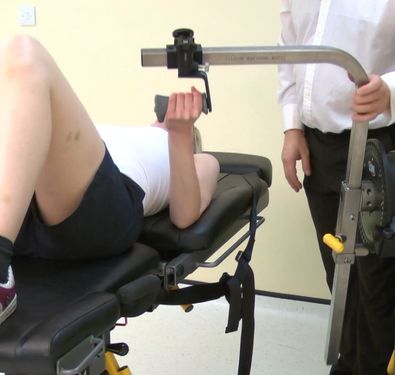
To view a set up video see below:
Lying position (90 degrees abduction):
The most stabilised position for testing and offers a good range of motion. Ensure the shoulder is at 90 dergrees abduction and is in the scapular plane (20 degrees scapular angle as seen below).
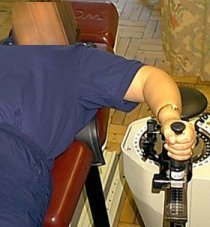
Seated position:
There are 2 main positions for testing the elbow in the seated position they are:
Seated Anatomical:
The most popular position as it tends to be the most comfortable. Although this position is not as stabilised as lying and does not allow as large a range of motion it is functional and gives the most usable results. Best for patients.
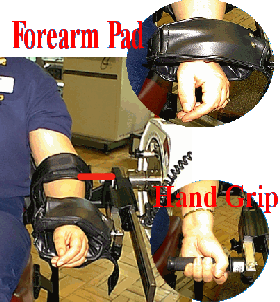
One of the main consideration is the height of the shoulder girdle. Most authors recommend neutralas the optimal position it is best to be guided by subject comfort try to avoid elevation or depression. Secondary straps can also be used for stabilisation (see below)
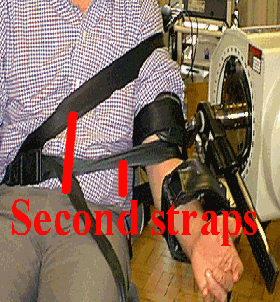
Seated (90 degrees abduction):
The less popular seated position as it linits the position of the scapular (placing it in almost full protraction). This position is more stabilised than anatomical seated, however, it does not allow as much range of motion. The position of the scapula and shoulder are set by lifting the arm to 90 degrees and protracting the scapular.
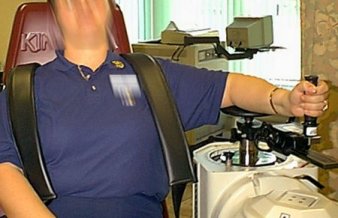
Standing position:
In the standing position (see below) stabilization is difficult if not impossible (and probably undesirable). Testing in this position is more functional than that in any other position expect correlation coefficients to be as low as 0.71.
Stabilisation:
Lying: In the lying position stabilisation normally only involves a pelvic strap and chest straps to prevent the torso from influencing the results. It is likely the shoulder will move during the test it can be held manually.
Standing: Stabilisation in the standing position is not normally required as this is the most functional position.
Seated: in the seated position stabilisation usually involves chest straps, an elbow pad and an elbow strap.
Attachments:
There is validity in using a wrist strap (as seen in seated anatomical picture above) rather than a grip handle (as seen in same picture) because this eliminates the influence of the wrist flexors and extensors. Although this may have some face validity it does not translate into real world testing. The hand grip is then always preferable and should be placed in the neutral position (see lying above) for any test.
Axis of rotation:
In any position the alignment of the instantaneous axis of rotation should be a point roughly 1 cm above the lateral epicondyle.
Anatomical zero:
With the arm straight.
Range of motion:
Generally a large range of motion is chosen for these tests. The test is often limited to the amount available before the arm hits the bicep.
Although it may be possible to go to extreme extension and flexion. An appropriate range of motion at the elbow would be between 20 degrees and 120 degrees. Avoiding full extension or flexion is better for peak and endurance testing but for sports specific tests an unlimited range of motion would allow a fuller examination of the concentric/eccentric ratios. Further, a limited range of motion at the beginning or end of range may be appropriate if acceleration and deceleration characteristics are of interest. However, the closer to the end of range the test becomes the more dangerous it becomes leaving the subject more prone to injury.
Extension down to 0 degrees can be used up to around 140 degrees of flexion any further is extension can lead to injury and any further into flexion can lead to muscular inefficiency ending the test early.
Gravity correction:
As the lever arm can be very long and heavy in these movements setting of gravity correction is essential. In patients gravity elimination (HumacNorm) can be very beneficial to reduce ballistic forces.
Speeds:
As velocities in some sports (any involving throwing an object) are known to reach thousands of degrees/second (Pappas et al., 1985) testing using a dynamometer has been said to be non-functional. However, speeds over 300 degrees/second have been found to be difficult to achieve by even baseball pitchers (Cook et al., 1987). This could be said to suggest that muscular effort starts the motion but only occurs at slower speeds with momentum and acceleration playing a larger role later in the speed of the motion later through range rather than pure strength. Even if this speed could be achieved it is over such a small arc that the results gained would likely be fruitless.
Generally it is accepted that speeds of 60 degrees/second and multiples of this should be used.
Elbow Flexion / Extension Protocols:
Muscles involved:
Biceps and triceps
| Strength Test Protocols | General | Patients | Athletes | Research |
| Contraction Cycle | con/con | con/con | con/concon/ecc | con/conecc/ecc |
| Speed/s | 60 or 120 | 60 or 120 | 60-300 | 60-500 |
| Trial Repetitions | 0 | 0 | 0 | 3 |
| Repetitions | 10 | 10 | 10 | 5 |
| Sets | 3 | 3 | 4 | up to 9 |
| Rest between sets | 20-30 secs | 20-30 secs | 20-30 secs | 20 secs |
| Rest between speeds | 2 minutes | 2 minutes | 2 minutes | 2-5 minutes |
| Rest between sides | 5 minutes | 5 minutes | 5 minutes | 5 minutes |
| Feedback | nil | nil | nil | nil |
| Endurance Test Protocols | General | Patients | Athletes | Research |
| Contraction Cycle | con/con | con/con | con/concon/ecc | con/conecc/ecc |
| Speed/s | 120 | 120 | 120-300 | 120-500 |
| Trial Repetitions | 0 | 0 | 0 | 0 |
| Repetitions | Max | Max | Max | Max |
| Sets | 1 | 1 | 1 | 1 |
| Rest between sets | N\A | N/A | N/A | N/A |
| Rest between speeds | 10-15 mins | 10-15 mins | 10-15 mins | 10-30 mins |
| Rest between sides | 5 mins | 5 mins | 5 mins | 5 mins |
| Feedback | nil | nil | nil | nil |
| Strength Exercise Protocol | General | Patients | Athletes |
| Contraction Cycle | con/con | con/con | con/ecc |
| Speed/s | 60 up to 180 | 60 up to 180 | 60-300 |
| Trial Repetitions | 0 | 0 | 0 |
| Repetitions | 10 | 10 | 14 |
| Sets | 6 | 6 | up to 12 |
| Rest between sets | 30-60 secs | 30-60 secs | 30 secs |
| Rest between speeds | 2 mins | 2 mins | 2 mins |
| Rest between sides | Nil | Nil | Nil |
| Feedback | bar | bar | bar |
| Endurance Exercise Protocol | General | Patients | Athletes |
| Contraction Cycle | con/con | con/con | con/con |
| Speed/s | 120-180 | 120-180 | 120-300 |
| Trial Repetitions | 0 | 0 | 0 |
| Repetitions | Max | Max | Max |
| Sets | 1-3 | 1 | 1-3 |
| Rest between sets | 5-10 mins | N/A | 5-10 mins |
| Rest between speeds | 10-30 mins | N/A | 10-30 mins |
| Rest between sides | Nil | Nil | Nil |
| Feedback | bar/pie chart | bar/pie chart | bar/pie chart |
Notes:
Test the uninvolved or dominant limb first.
Interpretation:
In the elbow it is normal to look at the ratio between the right and left sides there should be a 0-10% difference between the sides. Anything beyond this would either demonstrate extreme hand dominance (this can happen in certain sports like javelin), or indicate a muscle imbalance which would be best corrected.
Eccentric results are generally 30% higher than concentric within the same muscle Ivey et al (1985) Davies (1984).
Generally the extensors are stronger than the flexors by 10% however results do ary between 10% stronger to 5% weaker
The angle of peak torque for the flexors and extensors has been shown (Stefanska 2006) to be at 48 degrees of flexion.
Bicep Tendonoitis/opathy:
In biceps tendonitis/opathy there is often a significant drop in range at the angle where the peak musculo-tendonis force passes through the affected part of the tendon.
Or in other words the drop could be at the begining, end or within range. The point of the drop indicates the part of the tendon injured.
Biecps concentric test reults.
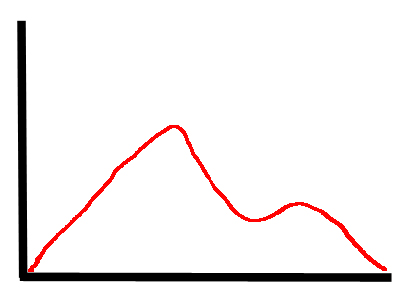
Normative values:
| Ellenbecker and Roetert (2003) | Age | Sex | Machine | PTBW (SD) | PTBW (SD) |
| speed deg/s | 13-17 | M | Cybex | Extension | Flexion |
| 90 Non Dominant | 55.1 (3.1) | 60.2 (4.2) | |||
| 210 | 52.4(3) | 52.4 (3.3) | |||
| 300 | 53.3 (2.73) | 53.9 (3.6) | |||
| 90 Dominant | 62.6 (3.3) | 61.3 (4) | |||
| 210 | 59.3 (3) | 54.8 (3.5) | |||
| 300 | 59.3 (2.73) | 55.1 (3.1) | |||
| F | |||||
| 90 Non Dominant | 51.2 (3.3) | 48.4 (1.9) | |||
| 210 | 43.6 (2.4) | 44.1 (1.5) | |||
| 300 | 43.3 (2.6) | 43.1 (2.5) | |||
| 90 Dominant | 54.9 (2.9) | 50.4 (3.1) | |||
| 210 | 52.2 (3) | 43.5 (2.4) | |||
| 300 | 52.5 (3.1) | 45.7(2.7) | |||
| Griffin (1987) 30d/s | 27 | F | 25.1 Con | ||
| 28 Ecc | |||||
| Hortobagyi & Katch (1990) | 23 | M | |||
| 30 | 37.3 Con | 41.5 Con | |||
| 30 | 53.7 Ecc | 54.9 Ecc | |||
| 60 | 36.4 Con | 39.7 Con | |||
| 60 | 55 Ecc | 55.6 Ecc | |||
| 120 | 35.7 Con | 37.8 Con | |||
| 120 | 54.8 Ecc | 57.1 Ecc |
| Biodex PTBW | Seated | Male | Female | ||
| Elbow Flexion | 60 | 21 | 28 | 20 | 26 |
| 120 | 21 | 28 | 34 | 45 | |
| Elbow extension | 60 | 21 | 28 | 23 | 30 |
| 120 | 23 | 30 | 18 | 24 | |
Elbow flexion strength Nm (subjects tested seated)
| Concentric | Eccentric |
| 30/sec | 34 | 38 |
| 120/sec | 30 | 39 |
| 210/sec | 26 | 35 |
Adapted from Griffin (1987)
Elbow extension concentric strength age groups 45-78
| Female | Male |
| Dominant | ||
| 60/sec | 24 | 47 |
| 180/sec | 16 | 33 |
Adapted from Frontera et al. (1991)